Unidentified - Europe, Mediterranean, West Africa
A place for temporarily storing messages about species from Europe, Mediteranean and W. Africa until they are identified. See Unidentified -General Page for an index of unidentified categories. Please make a point of looking through these messages to see if you can help identify any of them.
Authorship detailsRudman, W.B., 2001 (June 26) Unidentified - Europe, Mediterranean, West Africa. [In] Sea Slug Forum. Australian Museum, Sydney. Available from http://www.seaslugforum.net/find/unidenteur
Related messages
Unknown Onchidoris from Scapa Flow, Scotland
December 2, 2009
From: Ian Smith
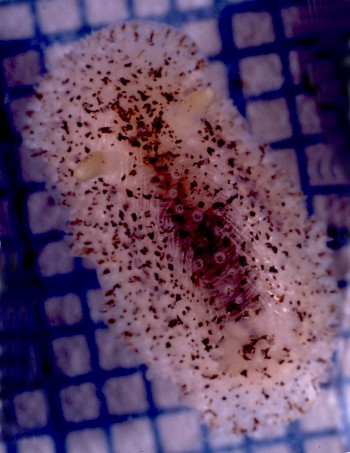
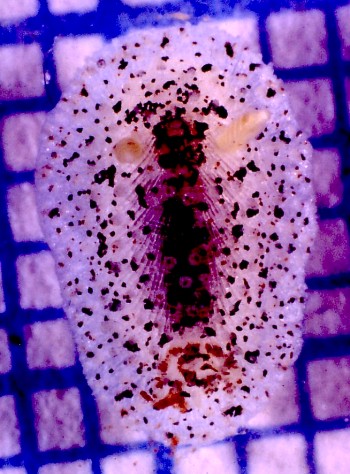
Dear Bill
Here are three images from Orkney that I am uncertain about. When found, I thought they were a pale form of Onchidoris sparsa, but I now have doubts as they appear so different from the specimen in my "typical O. sparsa" message [#22870].
I wonder if they might be the form of O. depressa with purple-brown spots instead of the usual orange brown, mentioned by Alder & Hancock and Thompson & Brown?
My concerns are:
1. "Glistening spicules" are clearly visible on these specimens, as described for O. depressa by Thompson & Brown, but not on my typical O. sparsa image.
2. Tubercles are difficult to discern in my pictures, but I think soft long tubercles (as described by A & H and T & B for O. depressa) show against the blue grid lines on the left-hand edge of the 10 mm specimen, about 3 mm from the posterior [upper photo].
Both species have tubercles with dark tips (Thompson & Brown); they show best over the dark gut in these photos and in my typical O. sparsa image where, seen from directly above, they appear as pale discs with very dark centres.
O. sparsa's "dorsum bears numerous small, rounded tubercles which often have a basal ring of dark pigment" (Thompson & Brown). The dark ring can be seen on my typical sparsa image, but not on these.
3. On O. sparsa "The pigmentation of the pallial epithelium around the rhinophores is usually different from the remainder, sometimes darker, more usually paler, and conspicuous pallial tubercles may arise from such areas, which may not be bilaterally symmetrical" (Farran,1903 in Thompson and Brown). All these features can be seen in my typical O. sparsa image, but none in these pictures.
I would be pleased to have the opinion of any other forum member with experience of these species.
Locality: Scapa Flow, Orkney, intertidal, Scotland, U.K., North Atlantic, 29 March 1975, Sheltered rocky shore. Length: 6 mm and 10 mm. Photographer: Ian F. Smith.
- Alder,J. and Hancock, A. 1845-1855, A monograph of the British nudibranchiate Mollusca parts 1-7, London, Ray Society
- Farran, G.P. 1903. The nudibranchiate molluscs of Ballynakill and Boffin harbours, Co. Galway. Rep. Sea and Island Fish. Ireland (1901) part 2, app. viii: 123-132.
- Thompson, T.E. and Brown, G.H. (1976) British Opisthobranch Molluscs. Linnean Society of London / Academic Press
- Thompson, T.E. and Brown, G.H. (1984) Biology of Opisthobranch Molluscs Vol 2. Ray Society, London .
Best wishes
Ian
ifsmith@bethere.co.uk
Smith, I. F., 2009 (Dec 2) Unknown Onchidoris from Scapa Flow, Scotland. [Message in] Sea Slug Forum. Australian Museum, Sydney. Available from http://www.seaslugforum.net/find/22871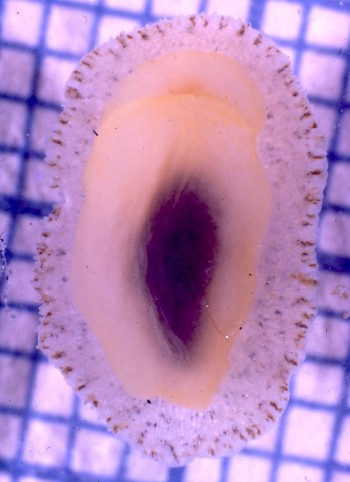
Thanks Ian,
This definitely requires some local knowledge. Thompson & Brown illustrate a similar looking species they identify as O. oblonga, but perhaps Greg or Bernard Picton could help us out
Best wishes,
Bill Rudman
Re: Another Mediterranean mystery
October 13, 2009
From: Marina Poddubetskaia Ossokine
Concerning message #1448:
Dear Bill,
It is another dorid which looks like Geitodoris planata. Somehow, the rhinophores and gills fit this species and I think I can see the distinctive yellow spots on the mantle. Do you have a closer view to confirm it, please ?
Best wishes,
Marina
nembro@yahoo.fr
Poddubetskaia Ossokine, M., 2009 (Oct 13) Re: Another Mediterranean mystery. [Message in] Sea Slug Forum. Australian Museum, Sydney. Available from http://www.seaslugforum.net/find/22699Dear Marina,
Thanks, but I don't have a higher resolution photo - this was early days on the Forum and computer monitors couldn't handle high resolution files. I tend to agree with you but I suspect it is best to consider this one unidentifiable.
Best wishes,
Bill Rudman
Re: Discodoris stellifera? from the Mediterranean
October 12, 2009
From: Philip Cromwell
Concerning message #22563:
Dear Bill,
I was wondering if this animal might not be Thordisa azmanii, with its papillae retracted.
Cheers,
Phil
aegir429@yahoo.com
Cromwell, P., 2009 (Oct 12) Re: Discodoris stellifera? from the Mediterranean. [Message in] Sea Slug Forum. Australian Museum, Sydney. Available from http://www.seaslugforum.net/find/22685Dear Phil,
It could possibly be that species but I am not sure if there are emergent vertical spicules present or not. Unfortunately with some nudibranch groups, photos alone are probably not enough for a positive identification
Best wishes,
Bill Rudman
Re: Discodoris stellifera? from the Mediterranean
October 8, 2009
From: Antonio Perrone
Concerning message #22563:
I am new to your wonderful and very interesting forum. I can confirm that the specimen is not Discodoris stellifera, nothing more. The specimen is very interesting and it appears to have spicules. The general external appearance recalls the genus Aldisa but also some old description of Mediterranean Thordisa (even if they are not the typical papillae of Thordisa). We know rather well the morphology of Thordisa filix but we do know nothing about the anatomy and the biology of a small group of rare taxa of ' Thordisa' described from the Mediterranean.
I hope to contribute to the forum in future
Antonio Perrone
antperrone@gmail.com
Perrone A.S., 2009 (Oct 8) Re: Discodoris stellifera? from the Mediterranean. [Message in] Sea Slug Forum. Australian Museum, Sydney. Available from http://www.seaslugforum.net/find/22686Dear Antonio,
Welcome to the Forum and thanks for your comments. The reason I included close-ups was because I wasn't sure if I was seeing spicules or not. If they are, they almost look like they could be described as caryophyllidia. I don't think species of Thordisa have large spicules like that, in fact I have had a quick look through the papers listed below and can't find any description of spicules in the mantle of Thordisa. But I could be wrong. Like you, I find the specimen quite puzzling.
I will move this to the unidentified Europe-Mediterranean list. I am reluctant to move things there because they tend to get forgotten. Perhaps it's a good time to ask you all to have a quick look through 'the unidentified' and see if you can help find a name for a few.
-
Chan, J. M. and T. M. Gosliner (2007). Preliminary phylogeny of Thordisa (Nudibranchia: Discodorididae) with descriptions of five new species. The Veliger 48(4): 284-308.
-
Valdes, A. and T. M. Gosliner (2001). Systematics and phylogeny of the caryophyllidia-bearing dorids (Mollusca, Nudibranchia), with descriptions of a new genus and four new species from Indo-Pacific deep waters. Zoological Journal of the Linnean Society 133: 103-198.
-
Valdes, A. (2002). A phylogenetic analysis and systematic revision of the cryptobranch dorids (Mollusca, Nudibranchia, Anthobranchia). Zoological Journal of the Linnean Society 136(5): 535-636.
Best wishes,
Bill Rudman
Re: Discodoris stellifera? from the Mediterranean
October 7, 2009
From: Dominique Horst
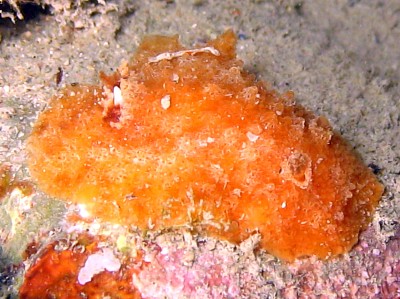
Concerning message #16467:
Hi Bill,
This is the first time I met this dorid and I am finding it hard to identify. I suggest Discodoris stellifera and probably a juvenile, which adds more difficulties.
Friends do not agree, so your help will be valuable.
Locality: Cagnes, 8 m, France, Mediterranean sea, 17 June 2009, muddy. Length: 20 mm. Photographer: Dominique Horst.
Kind regards,
Dominique
dominique.horst@wanadoo.fr
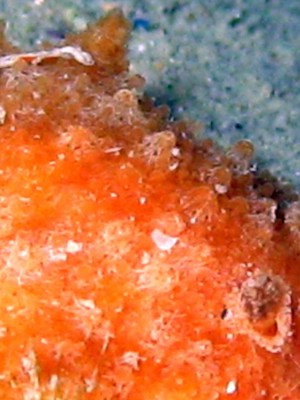
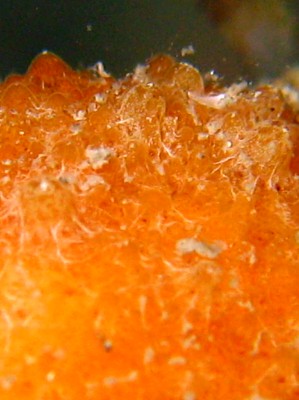
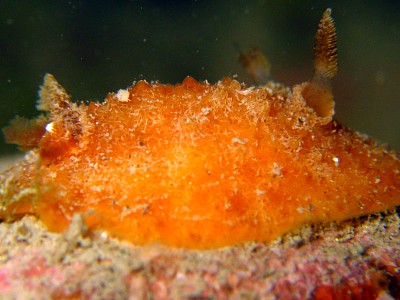
Dear Dom,
Discodoris stellifera and Geitodoris planata both have white star-like markings on the mantle but I am not confident that your animal is either of those species. Hopefully a local expert will be able to help us
Best wishes,
Bill Rudman
Re: Unidentified dorid from Mediterranean France
January 21, 2009
From: Sandrine Bielecki
Concerning message #22163:
The photographer said it was a small specimen < 1 cm found in 25 meters deep.
Sandrine Bielecki
sandrine.b3@free.fr
Bielecki, S., 2009 (Jan 21) Re: Unidentified dorid from Mediterranean France. [Message in] Sea Slug Forum. Australian Museum, Sydney. Available from http://www.seaslugforum.net/find/22173Thanks Sandrine,
It looks quite like Tom Turk's photo of Discodoris rosi [#13989] in which the rings are difficult to see, but juveniles are often difficult to identify without local knowledge. Hopefully a 'local' will be able to help us.
Best wishes,
Bill Rudman
Unidentified dorid from Mediterranean France
January 20, 2009
From: Sandrine Bielecki
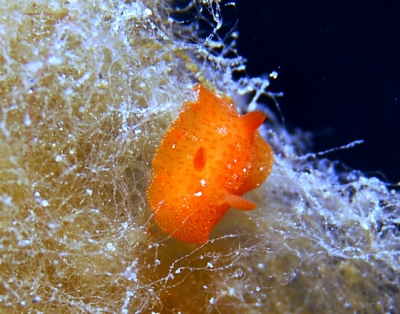
Hi Bill
Please help us to identify this slug, already debated on a french forum called "Doris" but without definitive conclusion.
An Aldisa sp ?
Locality: Cannes, France, Mediterranee, 20 September 2008. Photographer: Gilles Cavignaux.
Sandrine Bielecki
sandrine.b3@free.fr
Bielecki, S., 2009 (Jan 20) Unidentified dorid from Mediterranean France. [Message in] Sea Slug Forum. Australian Museum, Sydney. Available from http://www.seaslugforum.net/find/22163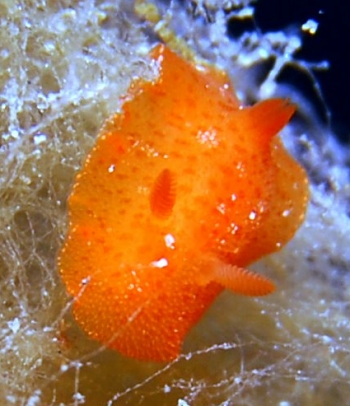
Dear Sandrine,
It is very useful to have an idea of the size of an animal because juveniles can look quite different from adults. From the size of the filaments in the background I assume this is quite a small specimen.
It does not have the characteristic dark markings usually found in the dorsal midline of an Aldisa, but that could be because it is a juvenile. The caryophyllidia like structires at the front of the mantle remind me a Rostanga but the shape of the rhinophores are quite different from the common red Rostanga rubra. One animal it looks very like is Discodoris rosi but it lacks the characteristic pale whitish rings on the mantle. Perhaps they are absent in juveniles?
Hopefully someone will be able to help you with an identification
Best wishes,
Bill Rudman
Unidentified species from Norway
June 20, 2007
From: Sven Gust
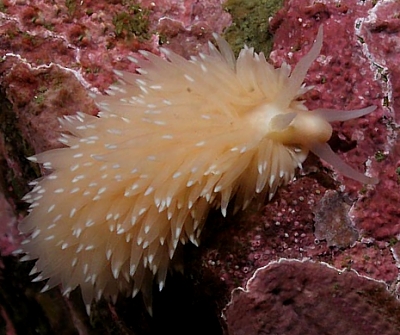
This one I found in April (7°C). I am not sure about the species.
Locality: Namsfjorden, 20, Norway, Norwegian Sea, April 2006, Hard bottom. Length: 50-60 mm. Photographer: Sven Gust.
Sven Gust
sven@tauchprojekt.de
Gust, S., 2007 (Jun 20) Unidentified species from Norway. [Message in] Sea Slug Forum. Australian Museum, Sydney. Available from http://www.seaslugforum.net/find/19431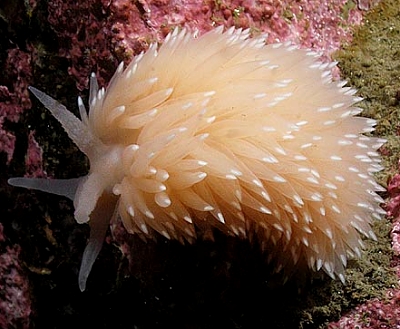
Dear Sven,
This one had me puzzled so I have been trying to get an identification for you without success. Perhaps the best way is to just post it on the Forum. If anyone can help with an identification I would be grateful.
Best wishes,
Bill Rudman
Unknown polycerid from Malta
May 23, 2007
From: Patricia Peels
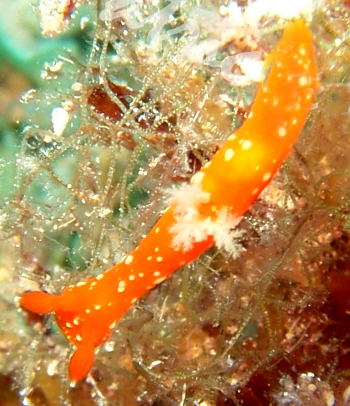
Hallo Bill,
Can you please help with the identification of this nudibranch?
I thought maybe some kind of Hypselodoris but then the gills don't seem right and neither could I find one matching in colour.
Locality: Cirkewwa, approx. 20 m, Malta, Mediterranean Sea, 22 September 2006, Wall with some algae growth. Length: approx. 2 cm. Photographer: Patricia Peels.
Thank you,
Patricia
gmpeels@nextgen.net.mt
Peels, P., 2007 (May 23) Unknown polycerid from Malta. [Message in] Sea Slug Forum. Australian Museum, Sydney. Available from http://www.seaslugforum.net/find/19185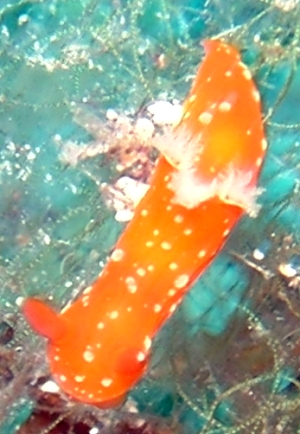
Dear Patricia,
Let's see if some local expert recognises this species. It is surely a polycerid, but I can't say I recognise it. There are a couple of Indo-West Pacific polycerids with similar colour patterns but I dont think they are close enough to consider. It's unusual to find an unidentifiable species in the Mediterranean so I will be interested in any response we get.
Best wishes,
Bill Rudman
Hypselodoris from Malta
February 14, 2007
From: Patricia Peels
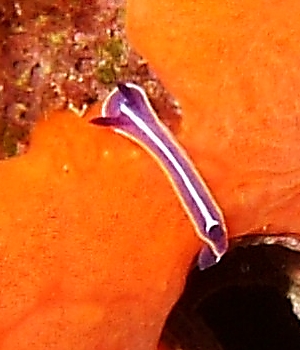
Dear Bill,
Going through my photos I've come across quite a few which are not clearly identified. Could you please help me out? I'm pretty sure it's some kind of Hypselodoris.
Locality: Cirkewwa, 20 m, Malta, Mediterranean, 30 May 2005, wall. Length: 10 mm. Photographer: Patricia Peels.
Thanks for your help
Patricia
gmpeels@nextgen.net.mt
Peels, P., 2007 (Feb 14) Hypselodoris from Malta. [Message in] Sea Slug Forum. Australian Museum, Sydney. Available from http://www.seaslugforum.net/find/19451
Dear Patricia,
It looks like Hypselodoris tricolor but usually there are signs of white patches on each side of mantle, and white on the gills. It is also quite like juveniles of H. orsinii but in that species the yellow/white line around the mantle edge is submarginal not marginal, and the mantle doesn't have the anterior end of the mantle widened as in these photos.
Hopefully someone with local knowledge can help us with an identification. These blue chromodorids from the Mediterranean are quite difficult
Best wishes,
Bill Rudman
Hypselodoris gasconi? from the Adriatic
June 2, 2006
From: Cristian Magnani
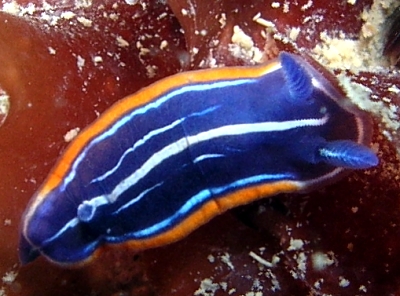
Dear Bill
Recently I found a small Hypselodoris while diving. I thought it had to be a specimen of Hypselodoris villafranca - that is pretty common in this area - so I took just a few quick shoots and moved on. Once at home I realized it was something different: I think it is Hypselodoris gasconi according to the book by Egidio Trainito. If i am right it is the very first sighting of this Hypselodoris in our area. I saw there are no pictures of this nudibranch on the forum hence I wish to share my ones.
Locality: Numana, 10 mt, Italy, Adriatic Sea, 06 May 2006, sandy bottom with scattered rocks. Length: 10 mm. Photographer: Cristian Magnani.
Thanks you so much!
Best wishes
Cristian
cristianmagnani@hotmail.com
Magnani, C., 2006 (Jun 2) Hypselodoris gasconi? from the Adriatic. [Message in] Sea Slug Forum. Australian Museum, Sydney. Available from http://www.seaslugforum.net/find/16566Dear Cristian,
Another interesting 'blue chromodorid'. I hope a local expert can confirm its identification. It also looks like some forms of H. villafranca and juvenile H. orsinii so I had a look at the original description of the H. gasconi. In that (Ortea et al, 1996) it says that 'the edge of the mantle is orange and can have the zones in front of the rhinophores and behind the gills replaced with white.' which certainly fits your photo, but can also occur in both the other two species I mention above. Ortea says H. gasconi can be differentiated from H. villafranca because the mantle border in H. gasconi is a 'strong' orange.
One difference between your animal and Ortea's illustrations of H. gasconi is the presence of a white line close to the orange border. This is not present in Ortea's description, but is present in photos (Fig 5B, C) of juvenile H. villafranca.
-
Ortea, J., Valdes, A. & Garcia-Gomez, J.C. (1996) Review of the atlantic species of the Family Chromodorididae (Mollusca: Nudibranchia) of the blue chromatic group. Avicennia (Suppl. 1): 1-160
Hopefully a local expert can help us
Best wishes,
Bill Rudman
Tritoniid from SE Greenland
February 4, 2006
From: Bart van Heugten
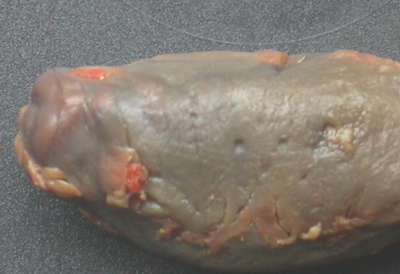
Who can help me with a determination on a nudibranch from about 400 m. depth, SE Greenland. The animal is about 5 cm the "jaw" is about 1 cm. It might be a Tritonia. .
Locality: SE Greenland, Atlantic. Depth: 400 m. Length: 5 mm. Nov. 2005. Trawled
Hope someone can help further
Bart van Heugten
bheugten@casema.nl

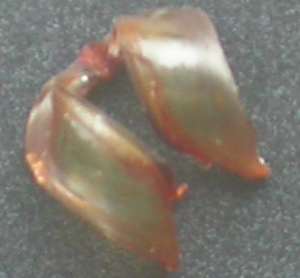
Dear Bart,
I agree it a tritoniid. Hopefully someone familar with that northern fauna can give us a name.
Best wishes,
Bill Rudman
Dorid from Slovenia [1]
October 1, 2005
From: tom turk
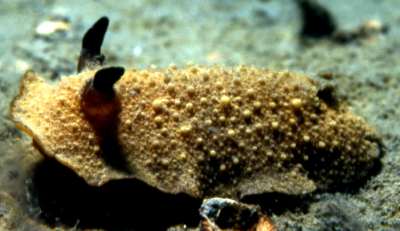
Dear Bill,
I am sending you a few photos of nudibranches from the Slovenian coast, which I need help identifying. Most of them were taken in the shallow infralitoral zone.
Locality: Piran, Slovenia. Adriatic Sea. Depth: from 1 to 15 m. Spring 2005
muddy, phytal. Photographer: Tihomir Makovec
Cheers,
Tom Turk
tom.turk@bf.uni-lj.si
Turk, T., 2005 (Oct 1) Dorid from Slovenia [1]. [Message in] Sea Slug Forum. Australian Museum, Sydney. Available from http://www.seaslugforum.net/find/13990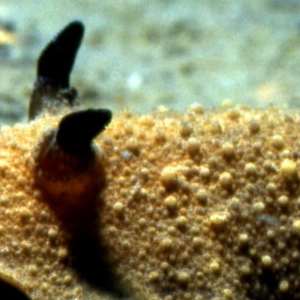
Dear Tom,
These tuberculate dorids are sometimes easy to confuse. Hopefully some one with a better knowledge of the Mediterranean fauna will recognise it for us
Best wishes,
Bill Rudman
Facelinid from Sao Tome Id., off west Africa
April 16, 2005
From: Gonçalo Calado
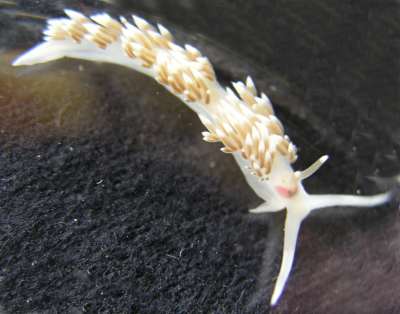
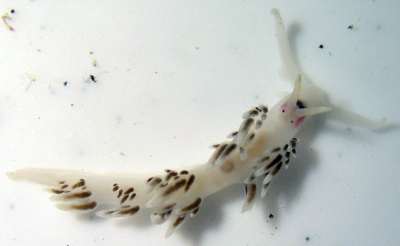
Hi Bill
Last February I've been in a field trip in São Tomé Island (just follow the equator line off West Africa and I collected this nudibranch. It seems to me a Facelinid. In fact it occupies the same habitat (underneath boulders) that Facelina coronata does in European waters. Any ID clue? They are about 2-3 cm long.
Locality: Rolas, Saõ Tomé e Príncepe Ids, Atlantic Ocean. Depth: 5-20 m. Length: 2.5 cm. 2 February 2005. Under boulders. Photographer: Gonçalo Calado.
Regards
Gonçalo Calado
bagoncas@netvisao.pt
Calado, G., 2005 (Apr 16) Facelinid from Sao Tome Id., off west Africa. [Message in] Sea Slug Forum. Australian Museum, Sydney. Available from http://www.seaslugforum.net/find/13430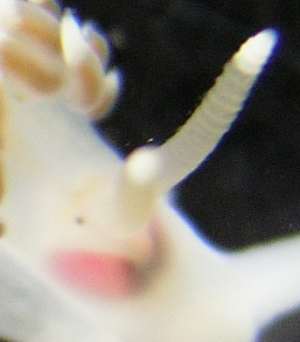
Dear Gonçalo,
It certainly looks like Facelina auriculata [= F. coronata] or possibly a species of Phidiana. The arrangement of relatively short cerata in distinct groups of rows is fairly characteristic. The structure of the rhinophores, which I have included in a close-up of one of your photos may be a useful character. The pink colour on the head is the colour of the jaw plates showing through the skin. I am not familiar enough with the Atlantic fauna to make a suggestion, but hopefully someone else can help
Best wishes,
Bill Rudman
Re: Unknown species from Norway
February 20, 2004
From: Jussi Evertsen
Hi!
Re Kåre's message [#12222]:
It does not look like any opisthobranch from Norwegian waters, not even any mollusc I know of. If I was to make a guess, I would suggest a tunicate, even though you can not see any siphon. A lot of species within the Ascidia and Ascidiella appear like a red blob.
Sincerely
Jussi Evertsen
www.nudibranchia.no
jussi.evertsen@bio.ntnu.no
Evertsen, J., 2004 (Feb 20) Re: Unknown species from Norway. [Message in] Sea Slug Forum. Australian Museum, Sydney. Available from http://www.seaslugforum.net/find/12266Thanks Jussi
Bill Rudman
Unknown species from Norway
February 19, 2004
From: Kåre Telnes
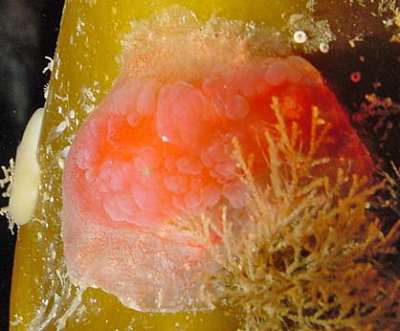
Hi!
I found this red blob on a an algae stem. The diameter is approximately 2-3 cm. The depth is 8 meters on a very current exposed location at the western coast of Norway (Stord). Do you have any idea of what it is? I cannot remember ever seeing anything like it before.
Regards
Kåre Telnes
kare@seawater.no
Telnes, K., 2004 (Feb 19) Unknown species from Norway. [Message in] Sea Slug Forum. Australian Museum, Sydney. Available from http://www.seaslugforum.net/find/12222Dear Kåre,
My guess would be a sea anemone, but hopefully someone with knowledge of the North Atlantic fauna can give us a better idea.
Best wishes
Bill Rudman
Flabellina from Cape Verde Islands
August 26, 2003
From: Gérard Breton
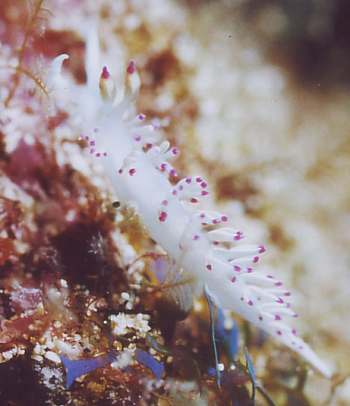
Dear Bill,
Here is another message from my dive trip between 22 - 30 March 2003 to two islands of the Cape Verde archipelago: Sal and Fogo.
From Sal, Puntinha, - 10m, on rocks. I have no idea of the ID of this aeolid which I have seen only once.
Best wishes.
Gérard Breton
Gerard.Breton@ville-lehavre.fr
Breton, G., 2003 (Aug 26) Flabellina from Cape Verde Islands. [Message in] Sea Slug Forum. Australian Museum, Sydney. Available from http://www.seaslugforum.net/find/10756Dear Gerard,
This certainly looks like a species of Flabellina. Ther are two species described from Cape Verde Islands. One of these, Flabellina llerae, has lamellate rhinophores, like your specimen, but has a deep purple body, and reddish tips to the cerata. Another species described from Cape Verde Ids, Flabellina bulbosa Ortea & Espinosa, 1998, has reddish-purple ceratal rings like your animal but the rhinophores are thins and slightly wrinkled. As its name suggests, the basal region of the oral tentacles is very swollen.
Hopefully someone with local knowledge can help us with an identification,
Best wishes,
Bill Rudman
Pleurobranch unknown to Portugal
June 26, 2003
From: Cesar Gavaia
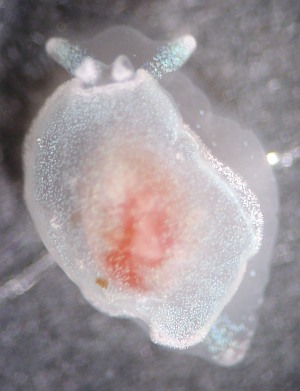
Hi everyone,
This pleurobranch (5mm long) was caught in Vale de Lobo (Algarve, Portugal), at 20 m depth, over mixed bottom of sand, gravel, empty shells and detritus, with ripple marks.
By the general morphology, I would say that it is probably a species of Berthella or Berthellina, but it doesn´t look like any of the pleurobranchs of these genera that are normally found in Portuguese waters (Berthella plumula , B. stellata, Berthellina edwardsi). Due to it´s very small size, I suppose it could be a juvenile of these species, but I have never seen such a small Berthella or Berthellina so I would´t know. Also, I have never seen pleurobranchs with iridiscent light blue speckling; this animal has them along the enrolled rinhophores, spread over the mantle, and also on the upper surface of the posterior tip of the foot.
I would appreciatte very much if someone could give me a clue, or even a final ID.
Best regards to all.
César Gavaia,
Portugal
cgavaia@hotmail.com
Gavaia, C., 2003 (Jun 26) Pleurobranch unknown to Portugal. [Message in] Sea Slug Forum. Australian Museum, Sydney. Available from http://www.seaslugforum.net/find/10207Thanks César,
I guess this is a juvenile. Hopefully someone will be able to give us an idea on its identity. It's interesting how the outer edges of the oral veil are covered in iridiscent light blue speckling, giving the impression of a pair of large oral tentacles.
Best wishes
Bill Rudman
Elysia viridis? f rom Malta
August 7, 2001
From: Erwin Köhler
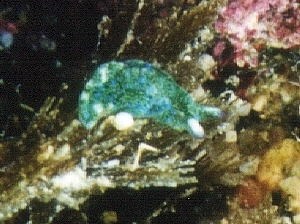
Dear Bill,
Attached is a photo from Malta. I took it at Mellieha, divesite "Popeye Village", at 7 m depth, size 6 mm, March 16, 2001.
I think this is Elysia viridis, but the partial white rhinopores are confusing me.
Erwin
Erwin@medslugs.de
Köhler, E., 2001 (Aug 7) Elysia viridis? f rom Malta. [Message in] Sea Slug Forum. Australian Museum, Sydney. Available from http://www.seaslugforum.net/find/4156Dear Erwin,
Perhaps someone has some ideas for us
Best wishes,
Bill Rudman.
Elysia translucens from southern France
June 8, 2001
From: Jean-Pierre Bielecki
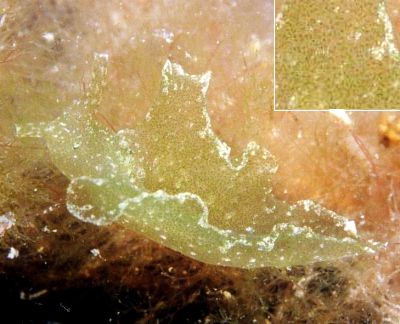
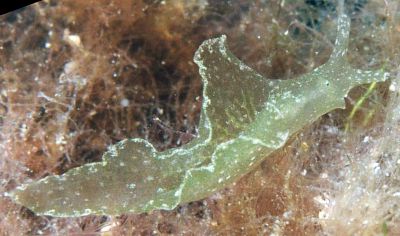
Hello Bill
Here is another species which needs identification. Thanks again for your help.
Sacoglossa - Elysia ?
Date: 27 may 2001
Place: France - Cap d'Antibes
Dive site: Le Grand Boule
Depth: 21m
Size: 15mm
Best wishes,
Jean-Pierre
bielecki.jeanpierre@free.fr
Bielecki, J-P., 2001 (Jun 8) Elysia translucens from southern France. [Message in] Sea Slug Forum. Australian Museum, Sydney. Available from http://www.seaslugforum.net/find/4506Dear Jean-Pierre,
This is a very transparent Elysia. I suspect it is one of those species which keeps the chloroplasts from its algal food alive in ite body. [see Solar-powered sea slugs]. My guess would be that it is Elysia translucens Pruvot-Fol 1957 which is known in the Mediterranean from Banyuls and Corsica to the Adriatic and Aegean.
I would however be grateful for confirmation of this identity from someone who knows the Mediterranean fauna.
• Bouchet, P. (1984) Les Elysiidae de Mediterranee. Annales de l'Institut Oceanographique, Paris, 60(1): 19-28.
• Thompson, T.E. (1981) Taxonomy of three misunderstood opisthobranchs from the northern Adriatic Sea. Journal of Molluscan Studies, 47(1): 73-79.
• Thompson, T.E., Jaklin, A. (1988) Eastern Mediterranean Opisthobranchia: Elysiidae (Sacoglossa = Ascoglossa). Journal of Molluscan Studies, 54: 59-69.
Best wishes,
Bill Rudman
Aplysia from the Canary Ids
April 5, 2001
From: Erwin Koehler
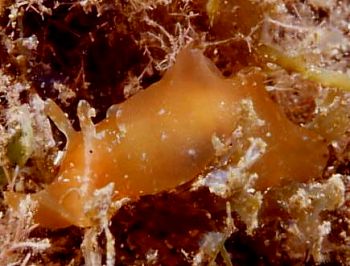
Dear Bill,
Attached is a photo from the Canary Islands
taken by Arthur J. Telle
Email: mercedes@idecnet.com
June 2000, size 2cm, depth 15m, Gran Canaria Island.
Erwin
Erwin@medslugs.de
Koehler, E., 2001 (Apr 5) Aplysia from the Canary Ids. [Message in] Sea Slug Forum. Australian Museum, Sydney. Available from http://www.seaslugforum.net/find/4091Dear Erwin,
It's definitely an Aplysia but I find the literature on the Atlantic species very confusing. I think it is probably Aplysia depilans, but hopefully a local expert will able tp tell us.
Best wishes,
Bill Rudman
Re: Another Mediterranean Mystery
September 24, 2000
From: Bernard Picton
Dear Bill,
Concerning Erwin's message (October 22 1999). I wonder if this is an Atagema species. I think I can see rhinophore sheaths but it's difficult to be sure. I have seen a small specimen of Atagema gibba and it looked rather like this. Perhaps we could ask Erwin to take a closer look at the ornamentation on the mantle and the possible rhinophore sheaths.
Bernard
bernard.picton.um@nics.gov.uk
Picton, B., 2000 (Sep 24) Re: Another Mediterranean Mystery . [Message in] Sea Slug Forum. Australian Museum, Sydney. Available from http://www.seaslugforum.net/find/3068Thanks Bernard,
Perhaps Erwin has a higher resolution file we could look at.
Best wishes,
Bill Rudman.
Re: Unknown dorid from Croatia
July 10, 2000
From: Juan Lucas Cervera
Dear Bill,
As I have said before, only a photo is often not enough to identify a nudibranch. The photographed animal is not Aldisa banyulensis nor A. smaragdina. To me, the "spot" that seems one of the typical features of the Mediterranean Aldisa spp. is only the branchial tuft, in this photo, although this is not clear. Internal anatomy would supply more light about the identity of this animal.
Cheers.
Lucas.
lucas.cervera@uca.es
Cervera, L., 2000 (Jul 10) Re: Unknown dorid from Croatia. [Message in] Sea Slug Forum. Australian Museum, Sydney. Available from http://www.seaslugforum.net/find/2676Thanks Lucas,
Looks like this is another one fated to a life in limbo on the 'unidentified' page.
Cheers,
Bill Rudman.
Unknown dorid from Croatia
July 2, 2000
From: Erwin Koehler
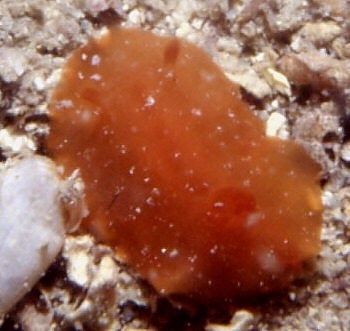
Dear Bill,
This photo was made by Petringa Alessandra, the daughter of Franco di Lorenzi
email cratena@libero.it
It was TAKEN in Croatia, Porec, divesite "Secca S. Nicola", July 17, 1999, at 9 m depth, size 12 mm.
Franco thinks it looks like Aldisa - can you or the Spanish experts help us?
Erwin
Medslugs.Koehler@t-online.de
Koehler, E., 2000 (Jul 2) Unknown dorid from Croatia. [Message in] Sea Slug Forum. Australian Museum, Sydney. Available from http://www.seaslugforum.net/find/2646Dear Erwin,
I think I will leave this to our European experts.
Best wishes,
Bill Rudman.
Another Mediterranean mystery
October 22, 1999
From: Erwin Koehler
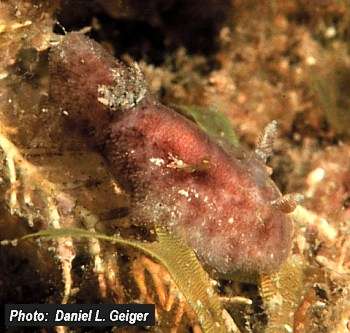
Note added 13 October 2009: This is possibly Geitodoris planata. See message #22699
Dear Bill,
Here is another of Daniel Geiger's photos which we are not sure of the identification.
Daniel thinks it might be Onchidoris inconspicua but I think this one looks different.
It is from Southern France, Ile de Bendor, July 1990.
Erwin.
Medslugs.Koehler@t-online.de
Koehler, E., 1999 (Oct 22) Another Mediterranean mystery. [Message in] Sea Slug Forum. Australian Museum, Sydney. Available from http://www.seaslugforum.net/find/1448Thanks Erwin,
I'll leave this to a local expert. It seems to have caryophyllidia over its mantle, like in species of Jorunna, but that may be an illusion.
Can anyone help us with an identification?
Bill Rudman.
Rudman, W.B., 1999 (Oct 22). Comment on Another Mediterranean mystery by Erwin Koehler. [Message in] Sea Slug Forum. Australian Museum, Sydney. Available from http://www.seaslugforum.net/find/1448